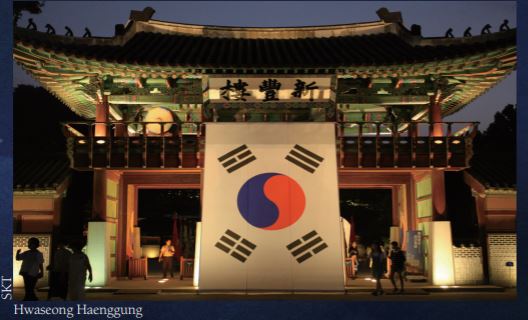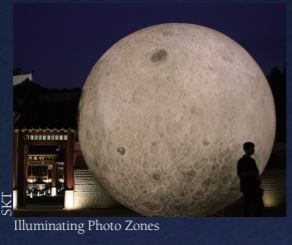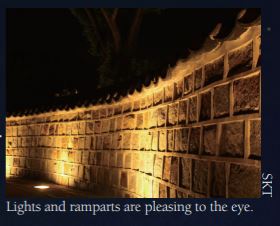With the beginning of a new semester in September, many Kingos will be busy. With a relatively relaxing schedule and cool weather, however, September just might be the perfect time to refresh and enjoy going outside. Then, how about going for a walk in a palace with a beautiful nightscape? The Sungkyun Times (SKT) will now introduce the night opening of Hwaseong Haenggung in Suwon that will remain open to the public through September 28th.

About Hwaseong Haenggung
The History of Suwon Hwaseong Fortress and Hwaseong Haenggung Suwon Hwaseong
Fortress is one of the major representative structures of the late Joseon Dynasty. It is also the unique symbol of Suwon-si. The Suwon Hwaseong Fortress was designated as a United Nations Educational, Scientific, and Cultural Organization (UNESCO) World Heritage site in December 1997. The Suwon Hwaseong Fortress began being built on October 10th, 1796 by the order of King Jeongjo, the 22nd king of the Joseon Dynasty. There were many reasons for the construction: first, he wanted to move the burial site of his father, Prince Sado. Also, he wanted to use the structure as a center for royal politics and a fortress protecting the south of the then-capital, Hanyang. Jeong Yak-yong, a famous scholar of the late Joseon Dynasty, designed the structure and made many inventions, such as Geojunggi, a type of crane which made it easy to construct the structure. Hwaseong Haenggung is a palace that is inside the Suwon Hwaseong Fortress. The haenggung is a temporary palace where the royal family stayed when they went outside of Seoul for a visit. It is the largest haenggung among the many temporary palaces constructed during the Joseon Dynasty. Although many parts of the palace were damaged during the period of Japanese occupation, it is recovering back to its old days’ thanks to a restoration project started in 1996. The first phase of the project was finished and the palace was open to the public in 2003. On June 8th, 2007, it was nationally designated as Historical Site No. 478.
The Beautiful View of the Palace After Sunset
How to Get to Hwaseong Haenggung
From the Natural Sciences Campus: It takes about 50 minutes via buses No. 61 or 62-1 departing from the campus’ bus station. From the Humanities and Social Sciences Campus: Kingos are recommended to use the inter-campus shuttle bus, and then take either the No. 61 or 62-1 bus. It takes about two hours from door-to-door.

Welcome to the Night Opening of Hwaseong Haenggung
The nighttime opening that began on July 2nd will be continued until September 28th. The opening hours are from 6 p.m. to 9 p.m. from Tuesdays to Saturdays every week, and the last entrance is at 8:30 p.m. Also, the Palace does not open during Chuseok, the traditional Korean holiday. According to Suwon-si, visitors can stay at the Palace during daytime until 6 p.m. for free. After 6 p.m., the Palace charges 1,500 won for adult admission, but visitors can gain free admission through various discount events such as adding the Hwaseong Haenggung as a KakaoTalk Plus Friend. Visitors can enjoy the nighttime opening in many ways. For example, there are several places to take amazing photos at the Palace, which are called the Illuminating Photo Zones. Interesting artworks such as moon-shaped objects will help visitors take memorable pictures. The reenactment actors and actresses across the Palace will tell the story of the Joseon Dynasty, and visitors can watch the show for free. Also, there is a chance to experience a Bicycle Taxi program, riding around the outer wall of the Palace on a tandem bicycle with a cultural commentator.

Experience Special Programs at the Palace
A total of seven experience programs are offered to the public at the Nangnamheon Hall, one of the structures at Hwaseong Haenggung. Visitors can choose and experience among the following programs; painting traditional patterns, drinking Jehotang and Omija Tea1), making Sotdae2), traditional candleholders, and grain soaps. The programs run from 5:30 p.m. to 9 p.m. and each program charges about 5,000 won to 15,000 won. These special programs provide an insight into the tradition of Suwon Hwaseong Fortress and Hwaseong Haenggung, a wooden rice chest that signifies Prince Sado3), and the traditional artistic designs of the Joseon Dynasty.

1) Jehotang and Omija Tea are traditional Korean cold drinks
2) Sotdae is a pole signifying prayer for a good harvest
3) Prince Sado died by being imprisoned in a rice chest, which was ordered by his father

